
Hemaris tityus, the narrow-bordered bee hawk-moth, is a moth of the family Sphingidae which is native to the Palearctic.

The willowherb hawkmoth is a moth in the family Sphingidae. The species was first described by Peter Simon Pallas in 1772.
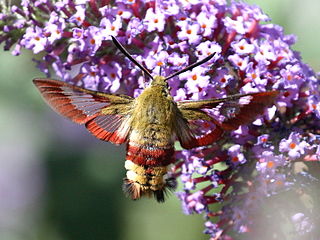
Hemaris fuciformis, known as the broad-bordered bee hawk-moth, is a moth of the family Sphingidae. It is found in North Africa, Europe and central and eastern Asia.

Marumba quercus, the oak hawk-moth, is a moth of the family Sphingidae. The species was first described by Michael Denis and Ignaz Schiffermüller in 1775.

Macroglossum glaucoptera, the dark hummingbird hawkmoth, is a moth of the family Sphingidae. It was described by Arthur Gardiner Butler in 1875. It is known from Sri Lanka, Thailand, southern China, Vietnam, Malaysia (Peninsular), Indonesia and the Philippines (Mindanao). Single specimen recorded from Papua New Guinea.

Acanthosphinx is a monotypic moth genus in the family Sphingidae erected by Per Olof Christopher Aurivillius in 1891. Its only species, Acanthosphinx guessfeldti, the widow sphinx, was first described by Hermann Dewitz in 1879. It is known from forests from Sierra Leone to the Congo, Angola, Zambia, Malawi, Tanzania and Uganda.
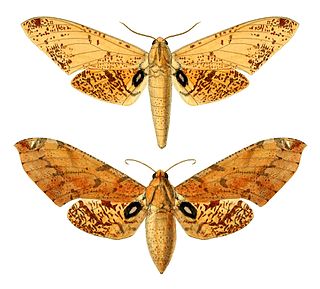
Platysphinx stigmatica is a moth of the family Sphingidae. It is known from forests from Nigeria to the Congo, Angola and western Uganda.

Basiothia medea, the small verdant hawk, is a moth of the family Sphingidae. It is common in open habitats throughout the Ethiopian Region, including Madagascar. It is however probably absent from the equatorial forest belt, except as a vagrant. The species is an active migrant.

Larunda is a genus of moths in the family Sphingidae, consisting of one species, Larunda molitor, which is known from open savanna and arid areas throughout tropical Africa.

Neopolyptychus pygarga is a moth of the family Sphingidae. It is known from forests in western Africa, including Cameroon and Nigeria.
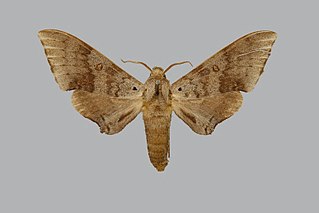
Neopolyptychus prionites is a moth of the family Sphingidae. It is known from lowland forests and heavy woodland from Guinea to the Congo and western Uganda.
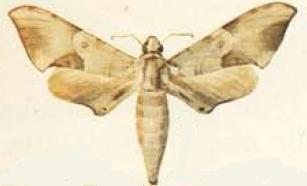
Neopolyptychus compar is a moth of the family Sphingidae. It is known from Brachystegia woodland from Zimbabwe to Mozambique, Zambia, Malawi and south-eastern Tanzania.

Polyptychoides grayii, or Gray's polyptychus, is a moth of the family Sphingidae. It is known from eastern Africa, south to South Africa.
Phylloxiphia bicolor is a moth of the family Sphingidae. It is known from forests from Sierra Leone to the Congo and Angola.
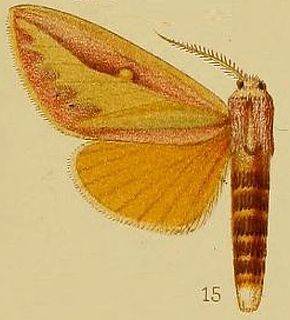
Leucophlebia afra is a moth of the family Sphingidae. It is found from Senegal to northern Uganda and Sudan in the east, and to Angola in the west.

Temnora funebris is a moth of the family Sphingidae first described by William Jacob Holland in 1893. It is known from the forests of western Africa to the Democratic Republic of the Congo, Uganda, Tanzania and Zimbabwe.

Temnora radiata is a moth of the family Sphingidae. It is found from West Africa to Angola.
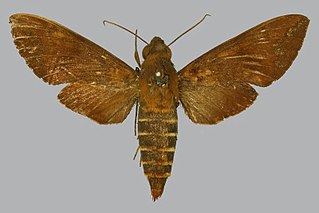
Nephele maculosa is a moth of the family Sphingidae. It is only known from the Congo-Cameroon equatorial forest belt.

Cechenena aegrota, the mottled green hawkmoth, is a species of moth in the family Sphingidae. It was described by Arthur Gardiner Butler in 1875. It is known from Nepal, north-eastern India, Bangladesh, Thailand, Laos, southern China and Vietnam.
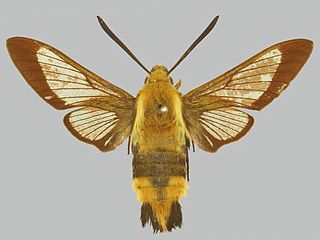
Hemaris affinis, the honeysuckle bee hawkmoth, is a moth of the family Sphingidae. It is known from Mongolia, the Russian Far East, northern, central and eastern China, Taiwan, North Korea, South Korea and Japan.
















